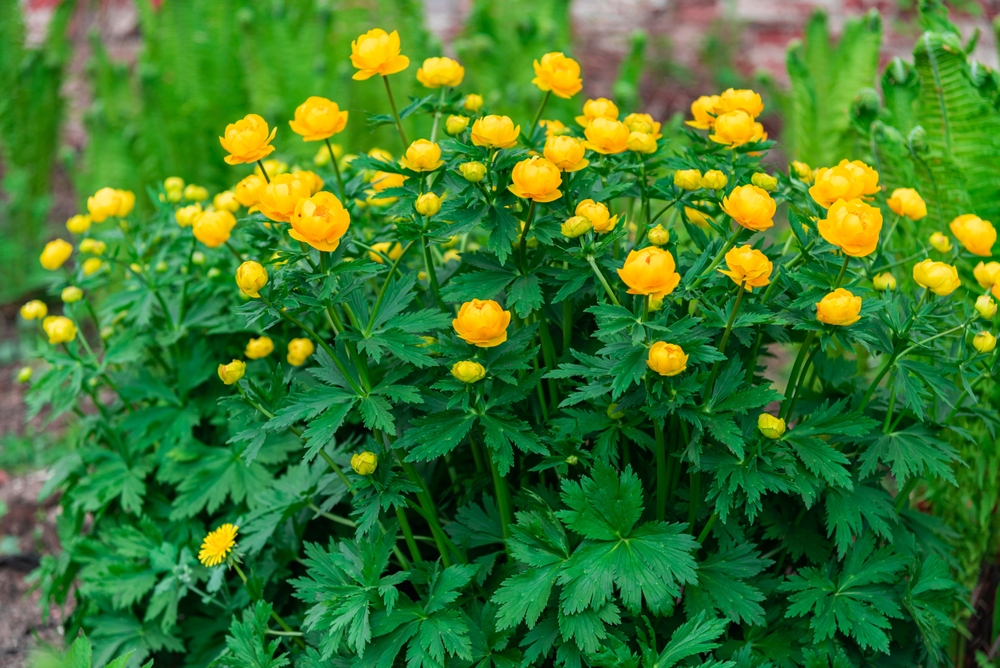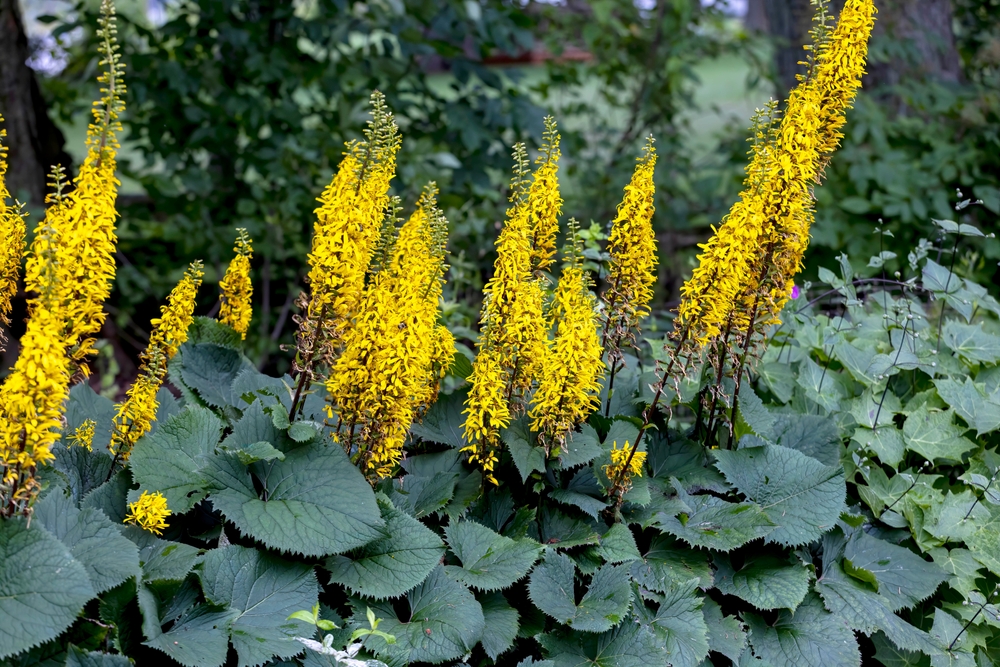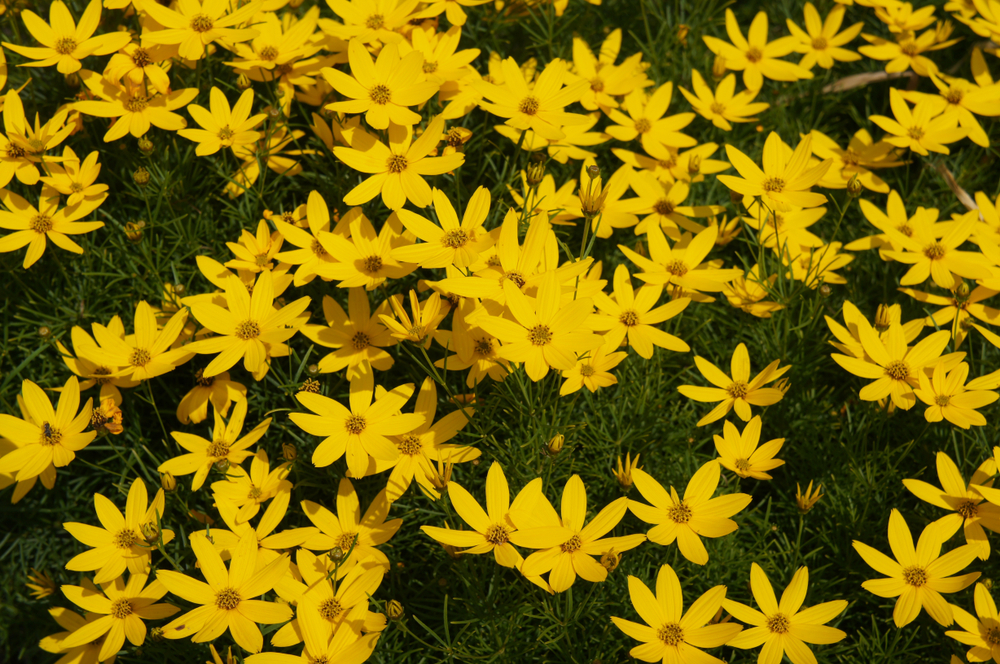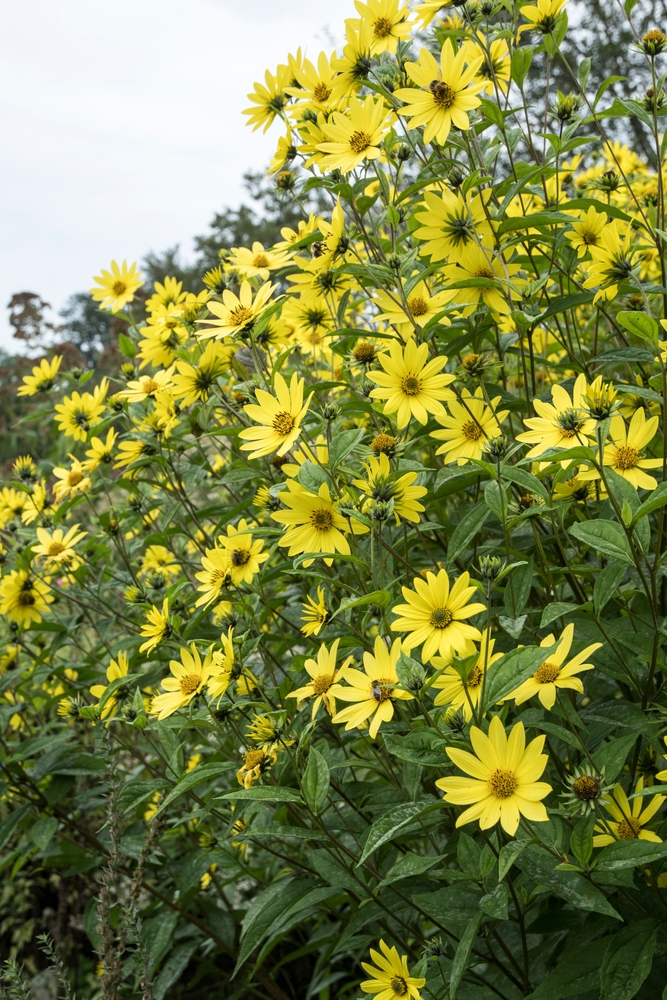Yellow, the color of sunshine, has the power to uplift even the gloomiest of spirits – just like the beautiful flowers in our garden! By adding a splash of yellow to your flowerbeds, you can bring more happiness and joy to your outdoor space. Our handpicked selection of the top 20 yellow flowers for your garden includes a variety of annuals, perennials, bulbs, and shrubs that will effortlessly incorporate a pop of yellow into your landscaping and container gardens.
Utilizing yellow flowers in your garden is a great way to make a statement, as this color is highly noticeable and catches the eye instantly. Ranging from soft, creamy hues to vibrant shades like school bus yellow and rich gold, yellow can be easily blended with other colors like orange and green to create a visually appealing display. Whether you opt for a bold yellow as a focal point or a subtle yellow to complement other shades, it’s important not to overwhelm the space with too much yellow. Combining yellow with blue or purple, its complementary color, can create a harmonious and visually striking effect in your garden.
Brighten up your garden with these sunny yellow flowers:
Bulbs with Yellow Flowers
1. Winter Aconite
This early blooming flower, Winter Aconite (Eranthis hyemalis), features delicate yellow cup-like flowers surrounded by ferny green leaves. Perfect for rock gardens or naturalizing under trees, this low-growing plant goes dormant in the summer months. Plant the tubers in the fall for a beautiful burst of yellow in your garden.
– Height ranges from 3 to 6 inches
– Thrives in full sun to partial shade
– Suitable for Zones 4 to 7
– Flowering occurs in the early spring

Aconite is one of the first flowers to bloom, often pushing through the snow. Daffodils, on the other hand, are the iconic heralds of spring with their vibrant yellow, orange, white, and pink blooms. For classic solid yellow daffodils, consider planting ‘King Alfred’ or ‘Dutch Master’ bulbs in the fall. They typically grow to be 14-16 inches tall and thrive in full sun to part shade in zones 3-8, blooming in mid-spring. Explore our daffodil growing tips for more information.

What could be more delightful than a cluster of bright daffodils swaying in the spring breeze? Yellow-flowered annuals are a fantastic way to add a pop of color to your garden all season long. Simply remove the fading blooms to keep the show going. Some top choices for yellow-flowered annuals that will keep blooming from summer through fall include the enchanting Calendula. Not only does this flower boast beauty, but it also has medicinal uses. Calendula petals are used to create healing salves, hand creams, and lip balms in herbal medicine. They can even be sprinkled on top of a salad for an edible garnish. Plus, bees and other pollinators are drawn to these lovely blossoms, making them a great addition to any garden.
There are a plethora of options available, with flowers in shades of yellow, orange, or cream, and varying in single, double, or semi-double blooms. Some petals even have touches of red at the tips or hidden underneath. If you prefer a solid yellow color, consider planting ‘Lady Godiva’ or ‘Pacific Beauty Yellow.’
• Height ranges from 12-24 inches
• Requires full sun
• Blooms continuously throughout the season until frost sets in
• Can be directly sown or transplanted.

Bees and other pollinators love the bright yellow flowers of calendula. Signet Marigolds, the smaller relatives of Marigolds, offer cheerful blooms in yellow ‘Lemon Gem’ variety. These plants have small, edible flowers and lemon-scented foliage, making them great for containers or as a border plant in your garden.
• Stands at a height and width of 12-18 inches
• Thrives in full sun
• Flowers from the beginning of summer until fall
• While it can be directly planted, it is advisable to transplant for quicker blooming time

‘Lemon Gem’ in bloom
Photo by Maria Papworth
5. Sunflowers
Sunflowers (Helianthus annuus) are the epitome of summer flowers! Their large, sunflower-like blooms come in an array of colors such as maroon, orange, red, burgundy, yellow, and even bi-color combinations.
These plants can range from short 12-inch dwarfs with multiple stems to towering 16-foot tall single stem varieties. For beautiful, fully double yellow flowers, consider planting ‘Goldy Double’ or ‘Lemonade.’ These branching plants produce numerous pollen-free, 5-7 inch wide flowers that are perfect for cutting. If you prefer classic tall sunflowers with yellow petals and brown centers, opt for the heirloom variety ‘Mammoth,’ which produces enormous 12-14 inch diameter seedheads that both you and the birds will appreciate.
– Heights vary based on the variety
– Requires full sun
– Blooms from July to September, depending on the variety
– Best results from direct sowing in the ground

Sunflowers follow the sun’s path, turning towards the east at night to prepare for the next day.
6. Bidens
Bidens are great for adding a cascading effect to your hanging baskets or mixed planters. With their feathery, blue-green leaves and small daisy-like blooms, Bidens bloom continuously from spring to frost. If they start to look too stretched out during the middle of the season, just trim them back a bit and they will produce new growth and more flowers. There are several new color variations to experiment with, but if you want a classic sunny yellow, consider ‘Goldilocks Rocks’ or ‘Yellow Sunshine.’
• Stands at a height of 12 inches with a width ranging from 1 to 3 feet
• Requires full sun for optimal growth
• Produces blooms from May to October
• Can be transferred to a different location

Bidens ferulifolia looks absolutely stunning when paired with other plants in a container garden.
Photo Credit: Tunatura
7. Celosias
These flowers have long-lasting plumes in various shades like pink, red, and yellow. Celosias can be preserved either fresh or dried for use in winter floral arrangements. Consider selecting ‘Sunday Gold’ which features feathery plumes that are 4-8 inches tall. The more you harvest, the more they will bloom, making them a wonderful addition to any cutting garden.
• Height: 30-40 inches
• Requires full sun
• Blooms from mid July until frost
• Best to transplant them for optimal growth

The charming and vibrant celosia blossoms instantly add a pop of color to any garden or floral arrangement they are included in. If you’re looking for a vine with yellow flowers, consider the Black-eyed Susan Vine (Thunbergia alata). This annual vine grows quickly and produces small yellow blooms with brown centers that resemble its namesake. It can be trained to climb up a trellis or teepee, creating a wall of blossoms throughout the season. In addition to the classic yellow variety, there are also options in pink, cream, red, apricot, white, salmon, and orange. To add some contrast to your garden, you can opt for the ‘Canary Eyes’ variety, which features yellow blooms with dark centers.
• Growing between 6 to 8 feet in height
• Thrives in both full sun and partial shade
• Best planted from mid-summer until frost
• Can be moved to a different location if needed

The Black-eyed Susan Vine is a great choice for quickly covering a post, tuteur, or fence in your garden. Another option for adding a pop of yellow to your garden is the Golden Alexanders, which are native perennials that bloom early in the season. These flowers are perfect for attracting pollinators like bees and butterflies, making them a must-have for your garden. Reaching a height of 3 feet, they thrive in full sun to part shade and can be grown in zones 3-8, blooming from April to June.

One of the butterflies commonly seen on golden alexanders is the Eastern tiger swallowtail butterfly female (Papilio glaucus), as captured beautifully in a photo by Kevin Collison. Another plant that thrives in tough conditions is yarrow (Achillea millefolium), known for its white flowers but also available in cultivars with pink, red, or yellow blossoms. Varieties like ‘Coronation Gold’ and ‘Moonshine’ offer stunning yellow flowers on top of gray-green foliage. Check out more on how to cultivate yarrow.
• Stands at a height of 2-3 feet
• Requires full sunlight
• Suitable for planting in zones 3-8
• Produces flowers from early summer to early autumn

Yarrow is irresistible to bees, and butterflies enjoy the wide, flat surfaces on the flowerheads for landing.
Next is the charming Black-eyed Susan (Rudbeckia hirta), a native perennial that may not live long but will spread by self-seeding. It’s a popular choice among pollinators and birds are big fans of its seeds. This plant thrives in hot and dry conditions, and it also serves as a host for various butterfly species.
Key characteristics:
– Height: 2-3 feet
– Requires full sun
– Suitable for Zones 3-7
– Blooms from June to September.

Black-eyed Susans are a familiar presence in many gardens due to their low maintenance and ease of growth. Goldenrod, commonly known as Solidago, often unfairly takes the blame for seasonal allergies when it is actually ragweed that is the culprit. With over 25 different species native to North America, Goldenrod includes varieties that prefer shade as well as those that flourish in full sunlight.
The goldenrod family is a valuable resource for various helpful insects, attracting numerous butterfly and moth species along with bees. With a wide variety of goldenrod options available, you can easily find the perfect fit for your garden. Consider adding a well-behaved sweet goldenrod like S.odora to your flower bed, as it grows in tidy clumps and is not invasive.
• Stands at 3 feet tall and wide
• Thrives in full sun to partial shade
• Suitable for Zones 4-9
• Blooms from August to September

Goldenrod is often overlooked and underappreciated, but there is a plant called Globeflower (Trollius europaeus) that deserves just as much love. This plant, a member of the buttercup family, produces two beautiful 2-inch wide, fully double, lemon-yellow blooms in late spring. With finely cut leaves and a neat, compact growth habit, Globeflower is visually appealing even when not in bloom. It thrives in cool, moist conditions and prefers to stay away from hot, arid areas. Growing to a height and width of 1 ½ to 2 feet, this plant does well in part to full shade and is suitable for zones 3-6. Enjoy its stunning blossoms from May to July.

The cheerful yellow Globeflower is guaranteed to brighten up your day with its vibrant color! The Leopard Plant, also known as ‘The Rocket’ (Ligularia przewalskii), stands at 3 feet tall and wide with big heart-shaped leaves. Its flower spikes, adorned with small yellow blooms, can reach up to 2 feet above the plant. This plant thrives in moist soil and is ideal for a rain garden in a shady area.
• Stands at a maximum of 5 feet when in full bloom
• Thrives in partial shade
• Suited for regions in Zones 4 through 8
• Boasts beautiful flowers from June to August

The Rocket plant is perfect for gardens that receive plenty of moisture and shade. This plant features bright yellow daisy-like flowers and delicate leaves, also known as tickseed or threadleaf coreopsis. Keep the plants trimmed after they bloom to encourage a second round of flowers in the autumn. Native to the eastern United States, this plant is a favorite among bees, birds, and butterflies. Popular varieties include ‘Moonbeam’ and ‘Zagreb’, which grow to be about 2-3 feet tall and thrive in full sun. These plants typically bloom from June to September and are suitable for zones 3-9. (Image courtesy: Karel Bock)

The coreopsis, also known as tickseed, is a perennial flower that blooms continuously from early summer all the way until the fall frost arrives. With its bright yellow blossoms, this flower adds a vibrant touch to any garden.
One of the early bloomers in the spring is the Lemon Lily, scientifically known as Hemerocallis lilioasphodelus. This daylily produces large, fragrant, lemon-yellow trumpet-shaped flowers that only last for a day. However, there are plenty of buds ready to take their place, ensuring a continuous display of blooms for a few weeks. Learn how to plant and care for daylilies to enjoy their beauty year after year.
• Height ranges from 2 to 3 feet
• Thrives in both full sun and partial shade
• Suitable for zones 4 to 10
• Produces beautiful blossoms during the months of May to June

Each year, I eagerly anticipate the blooming of the early lemon lilies. Their delightful fragrance is something I look forward to. Another delightful bloom that I love is the perennial sunflower ‘Lemon Queen’. This beautiful flower features daisy-like blossoms in a pale yellow shade, perfect for adding a pop of color to any garden. Standing at 5-8 feet tall and 3-4 feet wide, it makes for a stunning backdrop or can be planted along a fence for a lovely display. Originating in the Midwest, this species can thrive in various soil conditions and is a magnet for bees and butterflies. With blooms from July to October, ‘Lemon Queen’ is a must-have for any garden in zones 4-9.

The sunflower Helianthus ‘Lemon Queen’ is a vibrant perennial plant that adds a cheerful touch to any garden. Photo credit: Wiert Nieuman. One of the many shrubs with yellow flowers to consider is the Witch Hazel (Hamamelis virginiana). This shrub blooms during periods when not much else is flowering, typically in late fall or early spring. Witch Hazel, native to the eastern US, produces fragrant yellow blossoms that attract early bees and butterflies. It also serves as a host plant for Spring Azure butterflies’ caterpillars. There are various hybrids available that have been crossbred with Asian varieties, such as the popular ‘Arnold Promise’ and ‘Pallida,’ offering different bloom times for added variety in your garden.
– Growing between 15 to 20 feet in height and width
– Thrives in either full sun or partial shade
– Suitable for Zones 3 to 8
– Produces blooms from October to December

Witch hazel typically flowers so late in the season that it often ends up covered in snow. Spicebush, on the other hand, produces clusters of small, fragrant yellow flowers in early spring before its leaves even appear. Known as the “forsythia of the wilds,” it blooms around the same time as forsythia and can be encouraged to bloom earlier. This plant is native to the eastern United States and Canada, serving as the primary food source for Eastern Tiger Swallowtail and Spicebush Swallowtail butterflies in their larval stages.
• Height and width range from 6 to 12 feet
• Requires exposure to full sun or partial shade
• Suitable for planting in zones 4 to 9
• Blooms typically appear in the month of April

The blossoms of spicebush give off a delightful fragrance, and the leaves release a pleasant scent when crushed as well.
The Japanese Rose, also known as Kerria japonica, displays beautiful golden yellow flowers that resemble roses, with both single and double varieties available. It blooms in spring and often has a second bloom in late summer, making it a great addition to shady gardens. The flowers can fade to a pale yellow in full sun. If you prefer double flowers, consider planting the ‘Pleniflora’ variety.
• Reaches a height and width of 5-8 feet
• Thrives in partial shade to full shade
• Suitable for zones 4-9
• Blooms in April-May and again in August-September

The gracefully curving stems of kerria bloom with vibrant yellow flowers during the spring and once more in the late summer. The array of stunning yellow blooms is just a glimpse into the vast world of floral variety. Feel free to also delve into the realms of blue, pink, and white blossoms for even more inspiration.
